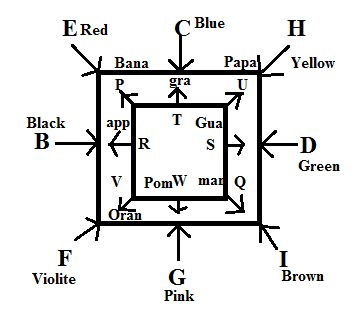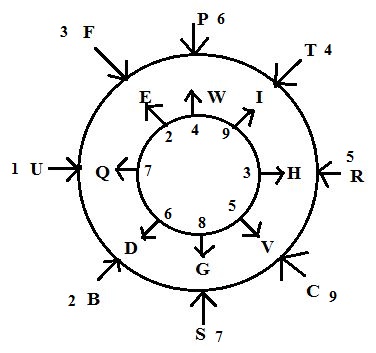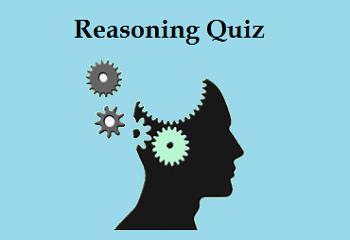Hello Aspirants.
Welcome to Online Reasoning Section with explanation in AffairsCloud.com. Here we are creating Best question samples from Seating Arrangements with explanation, which is common for competitive exams. We have included Some questions that are repeatedly asked in bank exams !!!
I. Study the following information carefully to answer the given questions.
There are 16 persons – B,C,D,E,F,G,H,I,P,Q,R,S,T,U,V and W standing in a square plot. Inside a Square plot, a square shaped garden is developed. The persons who are standing inside the garden facing outside. The persons who are standing outside the garden facing inside the centre and likes colours namely viz., – Red, Blue, Black, Brown, Yellow, Green, Violate and Pink. So all the persons standing in the inner square faces the persons standing in the outer Square and likes fruits namely viz., – Apple, Orange, Mango, Grapes, Papaya, Pomegranate, Guava and Banana.
G faces the centre and W faces G. D sits second to the right of G. There are four persons sits between G and E. D is not an immediate neighbour of E. There are three persons standing between I and E. There are two persons standing between I and B. B stands exactly between the E and F. F stands to the immediate left of G. There are two persons standing between W and U. U faces H. T faces outside. There are two persons standing between T and Q. T faces C. Q stands to the immediate left of W. R, the one who faces B stands exactly between the persons P and V. P faces E. The one who sits in the corner of the square likes Red. The one who likes Red sits between the persons who like Black and Blue. The one who likes Blue sits second to the right of the person who likes Green. Three persons sit between one who likes Black and one who likes Green. Two persons sit between one who likes Black and one who likes Yellow. Two persons sit between one who likes Yellow and one who likes Pink. G and F do not like Violate and Yellow respectively. The one who likes Red faces P. The immediate neighbours of P are the one who likes apple and the one who likes Grapes. The one who likes Apple faces the one who likes Black. Three persons sit between the one who likes apple and the one who likes Guava. The immediate neighbours of the person who likes Orange are the one who likes apple and the one who likes Pomegranate. The one who likes Papaya sits exactly behind to the one who likes Orange. The one who likes Banana sits exactly behind to the one who likes Mango. The one who likes Banana faces E.

- In the given arrangement, if three people come and stand to the immediate left of E, how many people will sit between F (From the left of F) and C?
A. Two
B. Three
C. Five
D. More than four
E. OneAnswer – C. Five - Who amongst the following likes Green?
A. C
B. B
C. Other than those given as options
D. D
E. EAnswer – D. D - How many people stand between V and U?
A. Two
B. Three
C. Four
D. More than four
E. OneAnswer – B. Three
- Four of the following five are alike in a certain way based upon their arrangement and so form a group. Which of the following does not belong to the group?
A. EP
B. FV
C. UH
D. GW
E. IQAnswer – D. GW - Who amongst the following likes Papaya?
A. P
B. U
C. Q
D. E
E. Other than those given as optionsAnswer – B. U
II. Study the following information carefully to answer the given questions.
There are 16 persons – B,C,D,E,F,G,H,I,P,Q,R,S,T,U,V and W standing in a Circular plot. Inside a circular plot, a circularly shaped garden is developed. The persons who are standing inside the garden facing outside. The persons who are standing outside the garden facing inside the centre and lives in a different number of floors. So all the persons standing in the inner circle faces the persons standing in the outer circle and hold a different number of chocolates.
G faces outside and S faces G. D sits immediate right of G. There are four persons sits between G and E. H is not an immediate neighbour of E. There are two persons standing between D and H. H faces R. There are three persons standing between R and U. U stands exactly between the B and F. B faces D. There are two persons standing between P and C. Neither S nor R is an immediate neighbour of P. I stands to the immediate left of H. I faces T. The one who faces F stands exactly between the persons Q and W. W faces P. H stands second to the left of G. B lives on the second floor and sits exactly opposite to the person who lives on the floor which is the square number of the floor of B. F lives on the third floor and stands exactly opposite to the person who lives on the floor which is the square number of the floor of F. P lives on 6th floor and S lives immediately above P. U lives immediately below B. R lives immediately above T. The one who faces P holds chocolates two less than the number of the floor occupied by P. The one who faces U holds chocolates six more than the number of the floor occupied by U. Number of chocolates hold by E is the difference between the number of chocolates hold by D and W. Number of chocolates hold by G is the sum of the number of chocolates hold by D and E also equals to number of chocolates hold by V and H. Number of chocolates hold by I is the square of the number of chocolates hold by H.

- In the given arrangement, how many people will sit between B and T?
A. Two
B. Three
C. Four
D. More than four
E. OneAnswer – B. Three - Who amongst the following lives on the seventh floor?
A. S
B. Q
C. Other than those given as options
D. U
E. CAnswer – A. S - If persons counted from the right of G, then how many people stand between G and E as per the given arrangement?
A. Five
B. Three
C. Four
D. More than four
E. TwoAnswer – E. Two
- Four of the following five are alike in a certain way based upon their seating arrangement and so form a group. Which of the following does not belong to the group?
A. F
B. E
C. C
D. G
E. VAnswer – D. G - Who amongst the following have seven chocolates?
A. T
B. F
C. Q
D. P
E. SAnswer – C. Q



